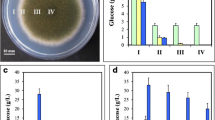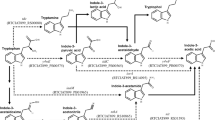Abstract
Fusarium graminearum produces trichothecene mycotoxins in infected grains and axenic liquid culture. A proposed regulatory model of trichothecene biosynthesis was examined in relation to nitrogen utilization. First, we showed that an important factor for the stimulation of trichothecene biosynthesis was not the occurrence of agmatine as a specific inducer molecule, but rather continuous acidification of the liquid culture medium arising from agmatine catabolism. When the pH of the l-Gln synthetic medium was frequently adjusted to the pH of the agmatine culture, trichothecene productivity of the l-Gln culture was equal to that of the agmatine culture. For efficient trichothecene biosynthesis, the culture pH should be lowered at an appropriate time point during the early growth stage. Second, we re-evaluated the role of the nitrogen regulatory GATA transcription factor AreA in trichothecene biosynthesis. Since Tri6 encodes a transcription factor indispensable for trichothecene biosynthesis, all fifteen AreA-binding consensus sequences in the Tri6 promoter were mutated. The mutant could catabolize l-Phe as the sole nitrogen source; furthermore, the pH profile of the synthetic l-Phe medium (initial pH 4.2) was the same as that of the wild-type (WT) strain. Under such conditions, the promoter mutant exhibited approximately 72% of the trichothecene productivity compared to the WT strain. Thus, F. graminearum AreA (FgAreAp) is dispensable for the functioning of the Tri6 promoter, but it contributes to the increased production of mycotoxin under mildly acidic conditions to some extent. Further investigations on the culture pH revealed that extremely low pH bypasses the function of FgAreAp.








Similar content being viewed by others
References
Desjardins AE (2009) From yellow rain to green wheat: 25 years of trichothecene biosynthesis research. J Agric Food Chem 57:4478–4484. https://doi.org/10.1021/jf9003847
Espeso EA, Penalva MA (1992) Carbon catabolite repression can account for the temporal pattern of expression of a penicillin biosynthetic gene in Aspergillus nidulans. Mol Microbiol 6:1457–1465. https://doi.org/10.1111/j.1365-2958.1992.tb00866.x
Etzerodt T, Maeda K, Nakajima Y, Laursen B, Fomsgaard IS, Kimura M (2015) 2,4-Dihydroxy-7-methoxy-2H-1,4-benzoxazin-3(4H)-one (DIMBOA) inhibits trichothecene production by Fusarium graminearum through suppression of Tri6 expression. Int J Food Microbiol 214:123–128. https://doi.org/10.1016/j.ijfoodmicro.2015.07.014
Feng B, Friedlin E, Marzluf GA (1994) A reporter gene analysis of penicillin biosynthesis gene expression in Penicillium chrysogenum and its regulation by nitrogen and glucose catabolite repression. Appl Environ Microbiol 60:4432–4439
Gardiner DM, Kazan K, Manners JM (2009) Nutrient profiling reveals potent inducers of trichothecene biosynthesis in Fusarium graminearum. Fungal Genet Biol 46:604–613. https://doi.org/10.1016/j.fgb.2009.04.004
Gardiner DM, Stiller J, Kazan K (2014) Genome sequence of Fusarium graminearum isolate CS3005. Genome Announc 2:e00227–e1214. https://doi.org/10.1128/genomeA.00227-14
Giese H, Sondergaard TE, Sørensen JL (2013) The AreA transcription factor in Fusarium graminearum regulates the use of some nonpreferred nitrogen sources and secondary metabolite production. Fungal Biol 117:814–821. https://doi.org/10.1016/j.funbio.2013.10.006
Hajjaj H, Niederberger P, Duboc P (2001) Lovastatin biosynthesis by Aspergillus terreus in a chemically defined medium. Appl Environ Microbiol 67:2596–2602. https://doi.org/10.1128/AEM.67.6.2596-2602.2001
Hou R, Jiang C, Zheng Q, Wang C, Xu JR (2015) The AreA transcription factor mediates the regulation of deoxynivalenol (DON) synthesis by ammonium and cyclic adenosine monophosphate (cAMP) signalling in Fusarium graminearum. Mol Plant Pathol 16:987–999. https://doi.org/10.1111/mpp.12254
Jiao F, Kawakami A, Nakajima T (2008) Effects of different carbon sources on trichothecene production and Tri gene expression by Fusarium graminearum in liquid culture. FEMS Microbiol Lett 285:212–219. https://doi.org/10.1111/j.1574-6968.2008.01235.x
Kazan K, Gardiner DM (2018) Transcriptomics of cereal-Fusarium graminearum interactions: what we have learned so far. Mol Plant Pathol 19:764–778. https://doi.org/10.1111/mpp.12561
Kimura M, Izawa K, Yoneyama K, Arie T, Kamakura T, Yamaguchi I (1995) A novel transformation system for Pyricularia oryzae: adhesion of regenerating fungal protoplasts to collagen-coated dishes. Biosci Biotechnol Biochem 59:1177–1180. https://doi.org/10.1271/bbb.59.1177
Kimura M, Tokai T, Takahashi-Ando N, Ohsato S, Fujimura M (2007) Molecular and genetic studies of Fusarium trichothecene biosynthesis: pathways, genes, and evolution. Biosci Biotechnol Biochem 71:2105–2123. https://doi.org/10.1271/bbb.70183
Kitou Y, Kosaki T, Maeda K, Tanahashi Y, Nakajima Y, Kanamaru K, Kobayashi T, Kimura M (2016a) Trichothecene production in axenic liquid culture of Fusarium graminearum using xylose as a carbon source. JSM Mycotoxins 66:17–19. https://doi.org/10.2520/myco.66.17
Kitou Y, Nakajima Y, Maeda K, Jin Q, Nishiuchi T, Kanamaru K, Kobayashi T, Kimura M (2016b) Re-examination of genetic and nutritional factors related to trichothecene biosynthesis in Fusarium graminearum. Biosci Biotechnol Biochem 80:414–417. https://doi.org/10.1080/09168451.2015.1088374
Maeda K, Ohsato S (2017) Molecular genetic characterization of Fusarium graminearum genes identified as encoding a precocene II-binding protein. JSM Mycotoxins 67:1–3. https://doi.org/10.2520/myco.67-1-3
Maeda K, Ichikawa H, Nakajima Y, Motoyama T, Ohsato S, Kanamaru K, Kobayashi T, Nishiuchi T, Osada H, Kimura M (2018) Identification and characterization of small molecule compounds that modulate trichothecene production by Fusarium graminearum. ACS Chem Biol 13:1260–1269. https://doi.org/10.1021/acschembio.8b00044
Martin JF, Casqueiro J, Kosalkova K, Marcos AT, Gutierrez S (1999) Penicillin and cephalosporin biosynthesis: mechanism of carbon catabolite regulation of penicillin production. Antonie Van Leeuwenhoek 75:21–31. https://doi.org/10.1023/A:1001820109140
McCormick SP, Alexander NJ, Proctor RH (2013) Trichothecene triangle: toxins, genes, and plant disease. In: Gang DR (ed) Recent advances in phytochemistry, phytochemicals, plant growth, and the environment. Springer International Publishing AG, Berlin, pp 1–17
Merhej J, Richard-Forget F, Barreau C (2011) Regulation of trichothecene biosynthesis in Fusarium: recent advances and new insights. Appl Microbiol Biotechnol 91:519–528. https://doi.org/10.1007/s00253-011-3397-x
Min K, Shin Y, Son H, Lee J, Kim JC, Choi GJ, Lee YW (2012) Functional analyses of the nitrogen regulatory gene areA in Gibberella zeae. FEMS Microbiol Lett 334:66–73. https://doi.org/10.1111/j.1574-6968.2012.02620.x
Nakajima Y, Tokai T, Maeda K, Tanaka A, Takahashi-Ando N, Kanamaru K, Kobayashi T, Kimura M (2014) A set of heterologous promoters useful for investigating gene functions in Fusarium graminearum. JSM Mycotoxins 64:147–152. https://doi.org/10.2520/myco.64.147
Nakajima Y, Maeda K, Jin Q, Takahashi-Ando N, Kanamaru K, Kobayashi T, Kimura M (2016) Oligosaccharides containing an α-(1 → 2) (glucosyl/xylosyl)-fructosyl linkage as inducer molecules of trichothecene biosynthesis for Fusarium graminearum. Int J Food Microbiol 238:215–221. https://doi.org/10.1016/j.ijfoodmicro.2016.09.011
Sambrook J, Fritsch EF, Maniatis T (1989) Molecular cloning: a laboratory manual Cold Spring Harbor Laboratory Press, Cold Spring Harbor, NY.
Shiobara T, Nakajima Y, Maeda K, Akasaka M, Kitou Y, Kanamaru K, Ohsato S, Kobayashi T, Nishiuchi T, Kimura M (2019) Identification of amino acids negatively affecting Fusarium trichothecene biosynthesis. Antonie Van Leeuwenhoek 112:471–478. https://doi.org/10.1007/s10482-018-1172-z
Wong KH, Hynes MJ, Davis MA (2008) Recent advances in nitrogen regulation: a comparison between Saccharomyces cerevisiae and filamentous fungi. Eukaryot Cell 7:917–925. https://doi.org/10.1128/EC.00076-08
Acknowledgements
This work was supported by grants from the Project of the NARO Bio-oriented Technology Research Advancement Institution (Research program on the development of innovative technology) (Grant number 28007AB) and Noda Institute for Scientific Research.
Author information
Authors and Affiliations
Corresponding author
Ethics declarations
Conflict of interest
The authors declare that they have no competing interests.
Ethical approval
This article does not contain any studies with human participants or animals performed by any of the authors.
Additional information
Communicated by M. Kupiec.
Publisher's Note
Springer Nature remains neutral with regard to jurisdictional claims in published maps and institutional affiliations.
Electronic supplementary material
Below is the link to the electronic supplementary material.
Rights and permissions
About this article
Cite this article
Nakajima, Y., Akasaka, M., Shiobara, T. et al. Impact of nitrogen metabolism-associated culture pH changes on regulation of Fusarium trichothecene biosynthesis: revision of roles of polyamine agmatine and transcription factor AreA. Curr Genet 66, 1179–1190 (2020). https://doi.org/10.1007/s00294-020-01102-x
Received:
Revised:
Accepted:
Published:
Issue Date:
DOI: https://doi.org/10.1007/s00294-020-01102-x




